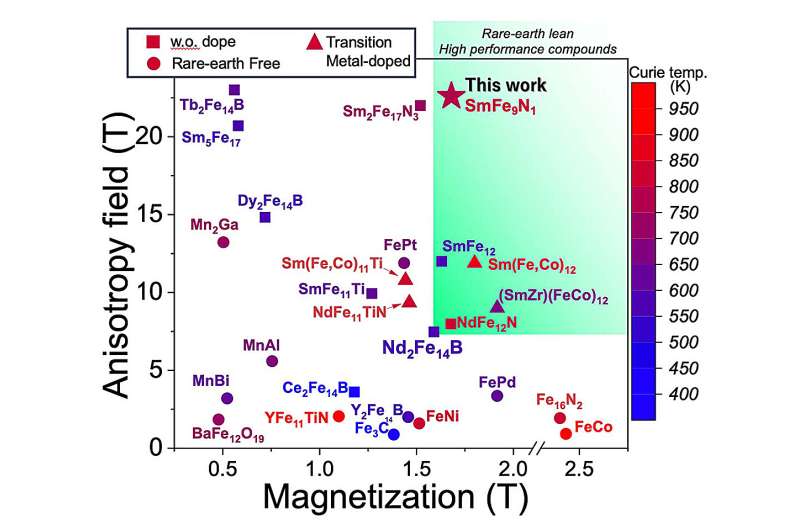This article has been reviewed according to Science X's editorial process and policies. Editors have highlighted the following attributes while ensuring the content's credibility:
fact-checked
peer-reviewed publication
trusted source
proofread
Synthesis of a new compound with excellent intrinsic magnetic properties using smaller amounts of rare earth elements

The National Institute for Materials Science has successfully synthesized a new SmFe-based magnetic compound, SmFe8.8N1.1, which possesses superior intrinsic magnetic properties when compared to those of NdFeB compound used in neodymium magnets. The study is published in the journal Acta Materialia.
To achieve a sustainable society, reducing carbon dioxide emissions is crucial. This necessitates the electrification of many devices and the enhancement of motor performance.
Neodymium magnets composed of the compound Nd2Fe14B, are widely used in electric vehicle drive motors due to their strong magnetic force.
However, neodymium magnets perform poorly at the high temperatures at which electric vehicles operate, requiring the addition of heavy rare-earth elements like dysprosium to compensate for thermal demagnetization. Due to the significant supply chain risks associated with neodymium and dysprosium, there has been a need to explore magnetic compounds that do not use these critical elements.
The Sm-Fe (1–7 series) compounds with a TbCu7-type crystal structure are expected to have high magnetization due to the possibility of increasing the Fe concentration up to a ratio of Sm:Fe=1:10.
However, the 1–7 series compounds have not been the focus of attention because of the proximity of the stable Th2Zn17-type Sm2Fe17(2–17 series) compound, which has a very high anisotropy field.
In this study, researchers successfully synthesized a single-crystal thin film of the SmFe8.8N1.1 compound, which is based on the Sm-Fe(1–7 series) compound with increased Fe concentration.
The magnetic properties of this compound were measured and found to surpass those of Nd2Fe14B, known as the world's strongest magnetic material, with an extremely high anisotropy field at room temperature (approximately 22 Tesla), higher saturation magnetization (1.64 Tesla), and a high Curie temperature (770 Kelvin).
Previous reports on SmFe7 series alloy powders lacked reliable magnetic measurements, but by creating single-crystal films in this study, it was demonstrated that the magnetic properties of this compound are significantly higher than those of traditional compounds.
Given that the magnetic properties of this compound surpass those of Nd2Fe14B at high temperatures, it is expected that magnets made from this compound could achieve excellent magnetic properties without the use of neodymium or dysprosium, which have supply chain concerns.
Moreover, since this compound uses samarium, a byproduct of rare-earth refinement, it promotes balanced use of rare earths. Additionally, the compound does not require expensive boron, making it advantageous in terms of resources and cost.
The researchers say they will develop methods to mass-produce SmFe8.8N1.1 powder and processes to compact the powder into magnets for practical applications.
More information: A.R. Dilipan et al, Excellent intrinsic magnetic properties in the TbCu7-type Sm-Fe-N compound, Acta Materialia (2024). DOI: 10.1016/j.actamat.2024.119996
Journal information: Acta Materialia
Provided by National Institute for Materials Science




















